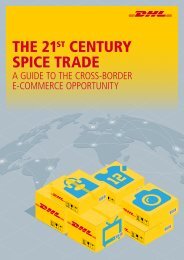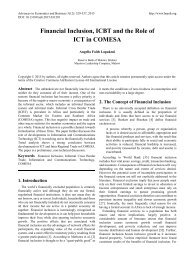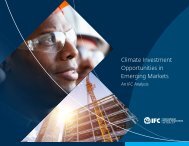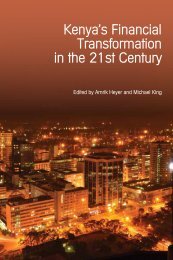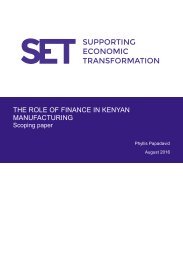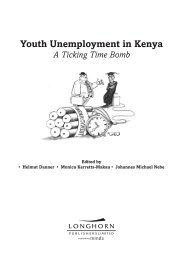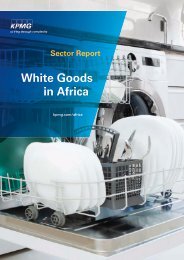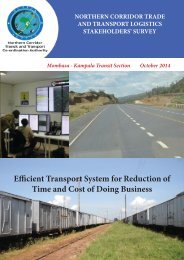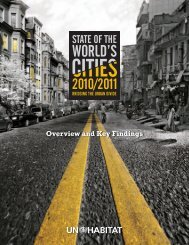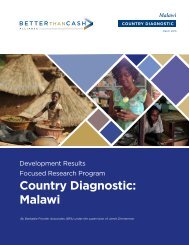FD
gvti301SEaf
gvti301SEaf
Create successful ePaper yourself
Turn your PDF publications into a flip-book with our unique Google optimized e-Paper software.
term “Washington Consensus”—sometimes also “neoliberal<br />
agenda”—has come to represent a general orientation toward<br />
market-based solutions for growth.<br />
Rodrik has said that “when I first began to criticize the<br />
Washington Consensus, I thought I was doing the obvious.” In a<br />
series of papers and books written during the 1990s and 2000s,<br />
he made three points against the Consensus. First, growth often<br />
happened as a result of “eclectic solutions” that combined the<br />
roles of the market and government. Second, growth was often<br />
triggered by one or a few changes and did not require a “long<br />
checklist” of reforms. Third, there were many pathways to<br />
growth, not a unique set of institutions and reforms.<br />
Rodrik provided many examples of successful industries in<br />
many countries that relied on a combination of market and<br />
state support. “Costa Rica is not a natural place to manufacture<br />
semiconductors,” he noted, but the government “got Intel<br />
to come in and do just that.” He argued that the historical<br />
record did not support assertions that the government cannot<br />
pick winners: “when economists say [this] they are really,<br />
for the most part, doing amateur political science.” What was<br />
more important, he said, was “to design institutions that …<br />
give the government the capacity to let go of the losers.”<br />
Relying on detailed case studies by other scholars, Rodrik<br />
also provided examples of “how little it takes for countries to<br />
suddenly experience a rapid growth spurt.” In Mauritius, it<br />
was the establishment of an export processing zone; in China,<br />
it was the introduction of the household responsibility system<br />
and a two-track price regime; in India it was a change<br />
in the government’s attitude from extreme hostility to being<br />
supportive of entrepreneurship. Hence, transitions to higher<br />
growth did not require a long checklist of actions. Countries<br />
could boost growth by identifying “the binding constraints”<br />
to growth and overcoming them through “well-designed but<br />
relatively minor interventions” (see Box 2).<br />
The case studies also showed there was “very little<br />
in common across [the] policy changes” that triggered<br />
growth, according to Rodrik. This suggested that there<br />
were many ways to grow. Moreover, a look at countries<br />
that were already rich—many in Europe, Japan, and the<br />
United States—showed that “you can end up being wealthy”<br />
despite differences in institutions and policies. Countries<br />
that had gotten richer more recently—those of east Asia in<br />
large part—had “marched to their own drummers and are<br />
hardly poster children for neoliberalism. East Asian countries<br />
would have been far worse off had they encountered<br />
something like the Washington Consensus. China would<br />
have been worse off if it had had no choice but to start the<br />
growth process through a structural adjustment loan from<br />
the World Bank.”<br />
Today, “the Washington Consensus is essentially dead,”<br />
Rodrik says, “replaced by a much more humble approach”<br />
that recognizes “we need a lot less consensus and a lot more<br />
experimentation.”<br />
Box 2<br />
Getting the diagnosis right<br />
With economists Ricardo Hausmann and Andrés Velasco,<br />
Dani Rodrik proposed a framework—called Growth<br />
Diagnostics—to help countries decide which reforms to<br />
pursue for growth. As the trio wrote in a March 2006 F&D<br />
article, countries should figure out a small number of binding<br />
constraints on growth and focus on overcoming those, rather<br />
than tackle a “laundry list of needed reforms.” Applying their<br />
method to El Salvador, they concluded that the binding constraint<br />
on growth was not a shortage of savings but a “dearth<br />
of ideas”: the country’s traditional sectors (such as cotton,<br />
coffee, and sugar) had declined, but no new ideas had sprung<br />
up for other potential investment sectors. They advised that<br />
encouraging more entrepreneurship and new business opportunities<br />
should be “at the center of [El Salvador’s] development<br />
strategy.” The Growth Diagnostics framework has been<br />
used by both the World Bank and the IMF as a complement<br />
to devising growth strategies. For instance, as applied by the<br />
IMF staff to Tunisia in 2016, the framework suggests that lack<br />
of “access to finance” was the binding constraint rather than<br />
infrastructure bottlenecks or a shortage of human capital.<br />
The revolution is over<br />
Andrei Shleifer, a Harvard colleague of Rodrik’s, often used<br />
to greet him in the corridors by asking, “How is the revolution<br />
going?” While there may have been some doubt about<br />
the answer when Rodrik started his Harvard career in 1985, it<br />
is clear three decades later that the revolution has succeeded.<br />
His warnings about the downsides of trade and its potential<br />
to create class divisions have become widely accepted.<br />
Harvard professor and former U.S. Treasury Secretary Larry<br />
Summers wrote in the Financial Times in April 2016 that “the<br />
core of the revolt against global integration … is not ignorance.<br />
It is a sense, not wholly unwarranted, that it is a project<br />
carried out by elites for elites with little consideration for the<br />
interests of ordinary people.”<br />
Rodrik’s caution about financial globalization is now<br />
widely shared, including at the IMF. Jonathan Ostry, an IMF<br />
deputy director who led the institution’s recent research on<br />
capital flows, says: “That Dani and the IMF can now have<br />
useful conversations about the design of capital controls is<br />
tribute both to his persistence and the institution’s flexibility.”<br />
The attacks on the Washington Consensus have led to<br />
greater humility in the advice international organizations<br />
offer countries on growth strategies. Rodrik noted that the<br />
IMF’s 2013 paper on growth strategies made a “plea for contextual<br />
analysis and recipes that sounds, to this set of ears at<br />
least, quite pleasing.”<br />
Rodrik himself seems to have acquired a deeper love of<br />
the profession he has often attacked. After two years at the<br />
Institute of Advanced Study, where his colleagues were<br />
drawn from various social sciences, he decided to return to<br />
the fold. His new book, Economics Rules—short-listed for<br />
the Financial Times’ best book award—tells noneconomists<br />
that “there is much to criticize in economics but there is also<br />
much to appreciate.” ■<br />
Prakash Loungani is a Division Chief in the IMF’s<br />
Research Department.<br />
Finance & Development June 2016 5



